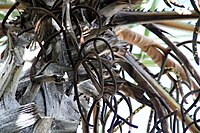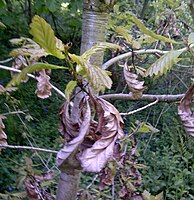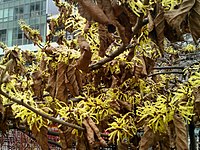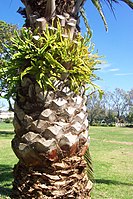Marcescence
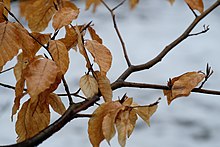


Marcescence is the withering and
Marcescent leaves may be retained indefinitely and do not break off until mechanical forces (wind for instance) cause the dry and brittle petioles to snap.[9] The evolutionary reasons for marcescence are not clear, theories include: protection of leaf buds from winter desiccation, and as a delayed source of nutrients or moisture-conserving mulch when the leaves finally fall and decompose in spring.[10]
Many
The term marcescent is also used in mycology to describe a mushroom which (unlike most species, described as "putrescent") can dry out, but later revive and continue to disperse spores.[15] Genus Marasmius is well known for this feature, which was considered taxonomically important by Elias Magnus Fries in his 1838 classification of the fungi.[16]
Advantages
One possible advantage of marcescent leaves is that they may deter feeding of large herbivores, such as deer and moose, which normally eat the twigs and their nutritious buds. Dead, dry leaves make the twigs less nutritious and less palatable.[17] They are also more noisy when browsed, thereby potentially deterring browsers.[18]
Species that display marcescence, such as beech and oak, have adapted to retaining their leaves for prolonged periods to thrive in difficult growing media. When growth is most vulnerable In the early stages of spring, they benefit from the compost provided by the newly dropped and decomposing leaves, allowing them to outcompete species that have already dropped theirs. It is suggested that such variations can significantly impact their success in such conditions. [19]
Some experimentation on plant litter from marcescent trees indicates that keeping the leaves above ground may increase the amount of photodegradation the leaves are exposed to. Because some marcescent species' leaves do not decompose well, the increased photodegradation may allow them to decompose better once they finally fall off the tree.[20]
Others theorize that leaves which remain on a tree due to marcescence allow the tree to trap snow during the winter months. By using their dead leaves to collect additional snow, trees are able to provide themselves more water in spring when the snow begins to melt.[21]
Marcescent leaves may protect some species from water stress or temperature stress. For example, in tropical alpine environments a wide variety of plants in different plant families and different parts of the world have evolved a
The litter-trapping marcescent leaf crowns of
Image gallery
Marcescence in various species.
Marcescent species
Marcescent species are found in the following (incomplete) list of plant genera:
- Agave
- Aloe
- Dendrosenecio
- Espeletia (frailejones)[22][23]
- Fagus (beeches)[3]
- Hamamelis (witch-hazels)[4]
- Quercus (oaks)[3]
- Salix
- Yucca
And in the following (incomplete) list of families:
See also
References
- ISBN 978-0-29574-288-5.
- ^ Chisholm, Hugh, ed. (1911). . Encyclopædia Britannica. Vol. 17 (11th ed.). Cambridge University Press. p. 685.
- ^ a b c d "Abscission and Marcescence in the Woods | Vermont Center for Ecostudies". vtecostudies.org. Retrieved 2017-11-16.
- ^ a b "When Leaves Don't Leave » Arnold Arboretum". Arnold Arboretum. 2016-02-19. Retrieved 2017-11-16.
- S2CID 84953073.
- ^ George W. Argus. "88. Salix planifolia Pursh". Flora of North America. Vol. 7.
- ^ "Species of Oaks That Retain Their Dead Leaves". Garden Guides. Retrieved 2017-11-16.
- S2CID 83740327.
- ISBN 978-0-520-04288-9.
- ^ "When Leaves Don't Leave » Arnold Arboretum". Arnold Arboretum. 2016-02-19. Retrieved 2017-11-16.
- ISBN 978-0-08-098445-2.
- ISBN 978-0-643-10185-2.
- ISBN 978-1-84246-182-2.
marcescent in immature [descriptive of several spp.]
- ^ Moore, Harold Emery; Uhl, Natalie W. (1982). Major Trends of Evolution in Palms. New York Botanical Garden. p. 69.
- ^ See introduction to Roy E. Halling "A revision of Collybia s.l. in the northeastern United States & adjacent Canada" Inst. of Syst. Botany, The New York Botanical Garden, Bronx, NY 10458-5126
- ^ E. M. Fries Epicrisis systematis mycologici (1838) Uppsala: Typographia Academica
- Gale A92803144.
- ^ Griffith, R. 2014. "Marcescence". YouTube. Archived from the original on 2021-12-21(video with narration).
{{cite web}}: CS1 maint: postscript (link) - ^ "Why Do Some Leaves Persist On Beech and Oak Trees Well Into Winter? | Winter 2010". Center for Northern Woodlands Education. Retrieved 2017-11-16.
- S2CID 25926164.
- ^ Woodlands, Northern. "Why Do Some Leaves Persist On Beech and Oak Trees Well Into Winter? | Winter 2010". Center for Northern Woodlands Education. Retrieved 2017-11-04.
- ^ .
- ^ JSTOR 2388171.
- ISBN 978-1-139-49780-0.
- ^ a b Kramer, Gregory T. (2011). "Palm Tree Susceptibility to Hemi-Epiphytic Parasitism by Ficus". (M.S. thesis). University of Florida.
External links
 Media related to Marcescence at Wikimedia Commons
Media related to Marcescence at Wikimedia Commons

